|
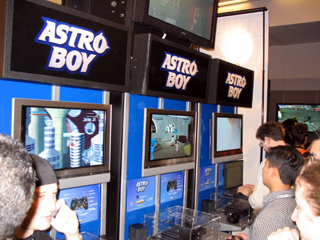
Astro Boy had a high-profile presence at this year's Sega E3 booth
Sega's Sonic Team seems like a perfect match for the Astro Boy cartoon license. The animated series is tailor-made for the kind of lighthearted, whimsical action game that the makers of the Sonic the Hedgehog series, Billy Hatcher, and Phantasy Star Online are so well known for.
Maybe the high-flying hero might even provide an opportunity for aerial acrobatics and fluid 2.5D gameplay on the order of fan favorite NiGHTS into Dreams? With these possibilites in mind, it was easy to approach the E3 showing of Astro Boy for PS2 with an optimistic attitude and rationalize away reports that the game was an absolute critical and sales flop in Japan. After all, many other perfectly good Sega games were flops in Japan. But after some hands-on playtime, it unfortunately looks like those gamers overseas may have been right to leave it on the shelf.
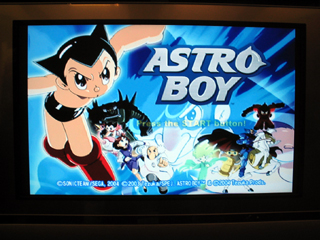
That Sonic Team logo at the bottom must be a mistake!
Immediately upon picking up the controller, you'll notice that for a simple looking game, Astro Boy's controls feel stiff and clumsy. They're overly complicated and ill-suited to the game engine and the action, and the average gamer is going to find moving around pretty awkward at first. Positioning the camera while controlling Astro Boy, aiming him quickly towards a desired direction, and targeting a location or enemy to fight were all basic functions that took more effort than they ought to in such a straightforward game. Let's take a look at the controls:
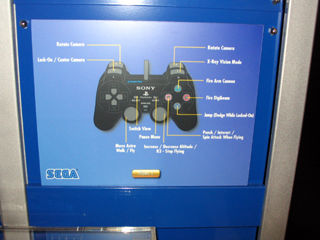
Astro Boy's unintuitive controls keep the gameplay from reaching the heights it could have
Notice how the left analog moves Astro Boy on the ground and in the air, while the right stick adjusts his altitude. So to have complete control over his flight, the player will have both thumbs taken up by the sticks alone! If you want to use offensive actions like firing the arm cannon or Digibeam or punching, you're going to have to give up the ability to move Astro up or down. This works poorly in practice, and facing and targeting enemies can be a chore.
Holding the Square button down allows the user to send Astro into a Spin Attack, which also functions as a sustainable turbo dash forward unless you're locked onto an enemy. During the Spin Attack, up and down movement can now be controlled with the left stick; no need to use the right one to adjust altitude. That's so much better - why isn't it like that by default?
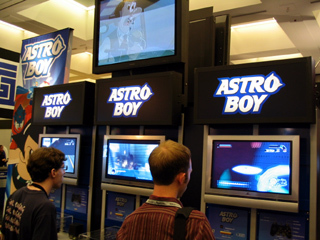
There were two playable levels available in the E3 demo: Atlas 2 and Magnamite
The Atlas 2 stage begins with Astro in a small town, where you can go into several buildings and talk with generally uninteresting non-player characters from the comic book and cartoon. Getting to the action portion of the stage can take a minute, as it's not clear exactly how to leave the limited confines of the village. Once Astro gets off the ground and flies into just the right spot, his exit into the level proper will be triggered. Off to Metro City!
Here you'll fight a variety of flying robots, but the control scheme can make dealing with multiple foes irritating at times. Though several attack options like the punch, Digibeam, and arm cannon are at your disposal, the combat doesn't feel very precise or fun. It's easy to miss while firing the digibeam or cannon, though using L1 to lock onto targets helps somewhat. As a Sega rep advised, a yellow lock-on indicates that the enemy is capable of being punched, while a green lock means a Spin Attack is possible. Though the reasoning behind why one or the other is displayed wasn't too clear, it may depend on enemy type. However, the Spin Attack is effective once you lock and nail a target with it. Keep hitting the Square button and Astro will continue to spin acrobatic manuvers into his opponent, resulting in combos that do greater damage.
The game engine affords limited 3D movement in all directions, but you'll frequently come up against invisible walls that block your progress. This can make the environments feel small and restrictive. As with the village, to progress to the next area you have to fly in just the right direction, and it's not always clear where that is.
It appears to be safe to say that Astro Boy won't be hailed as a return to form for Sonic Team. At this point, the game is not a work in progress, and only localization is left to be completed for the U.S. release this August. It might still be an enjoyable little game if you lower your expectations and prepare for a control scheme with an initial learning curve. But if you're the kind of Sega fan who's been waiting for the "next big thing" from Sonic Team after the likes of Billy Hatcher, Sonic Heroes, and Phantasy Star Online Episode III: CARD Revolution, you're going to have to keep on waiting a little longer.
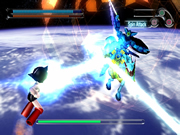 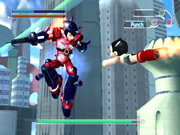 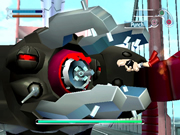 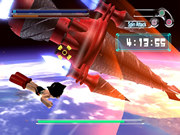
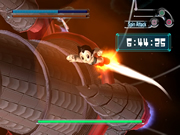 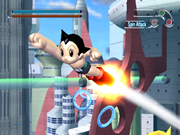 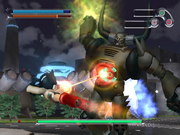 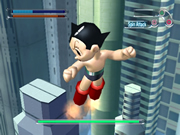
· · · Ted Boyke
|

